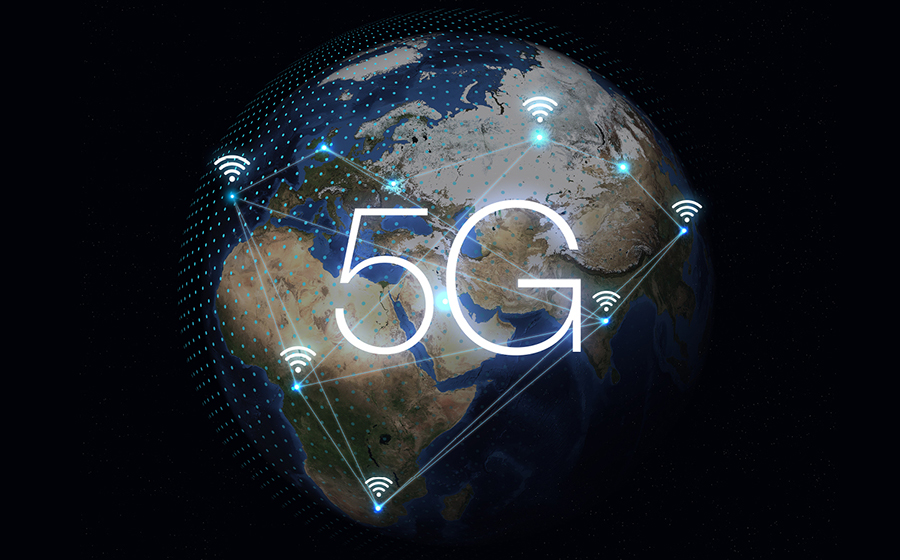Do you remember the term \”information superhighway?\” In the early to late 1990s it was the go-to expression used by every journalist, techno-geek and politician to explain the speed at which data was transmitted over the web.
However, the high-speed chase is accelerating with the advent of 5G technology, the designation for the 5th generation of mobile communication that could bring enormous benefits to retailing -or the biggest headache since you tried explaining the internet to your grandmother.
Digital Revolution
At its most ambitious, 5G is being billed as a new industrial revolution capable of transforming the customer experience. It is going to make driving the old information superhighway feel like a buggy ride down a country road. Data speed will be an estimated 100 times faster than the now-standard 4G and will be measured in gigabytes per second, enabling anyone to download and transfer data in seconds instead of minutes.
We\’re not only talking about smartphones, laptops, smart TVs and Smart homes. 5G will enable the advent of smart cities that bring cheap, ultra high-speed connectivity to every urban area enabling these areas to reduce traffic congestion and improve air quality and to rural areas where connectivity has been spotty.
The former is particularly important since an estimated 68 percent of the world\’s population will live in urban areas by 2050, according to United Nation\’s statistics. In fact, spending on smart city technology will reach $158 billion over the next three years led by Singapore, Tokyo and New York, according to IGD research.
On a personal and more humble note I look forward to any techno-evolution that will let me get a signal in my kitchen.
Sands of Time
For retailers, 5G will be the ultimate expression of the \”consumer experience,\” a strategy that often fails to produce what it promises. Not so with 5G. That spinning multi-colored circle and the excruciatingly slow hourglass that mark downloads and connection times will hopefully be a thing of the past. In a world focused on IoT and millions of IoT devices screaming for connectivity few things are more important.
There is also a new word being used in the 5G data transmission game-latency, or the speed at which data moves from a cell tower to any mobile or home device. The reduction in latency will help reduce traffic overload and lead to immediate website connection and super high-definition mobile video content. Imagine what this might mean for online sales during the holiday season when speed is of the essence. Or giving consumers the ability to receive mobile holograms, a sci-fi function that has yet to come to fruition.
Some in the IT world love geeking out with discussions of beamforming, pathloss, spectrum efficiency and the ever-popular MIMO (multiple-input, multiple-output). But the needs of consumers are far simpler. They just want to get the goods.
Enter the Dark Side
There is always a downside to new technology and 5G is no different. For one thing, the technology is still being developed and few experts in the field expect it to be fully operational for commercial use-and without its bugs-any time soon.
Even if it were out there en masse, 5G smartphones are going to start out being ultra-expensive and most consumers-even the most rabid Apple munchers-are not going to lay out the coin to replace their current models, particularly if the economy decides to take a dive.
Companies attempting to build or upgrade their own networks are also going to find 5G expensive and will have to allocate funds to hire skilled engineers and put in the manhours to maintain the system.
This is being complicated by political issues. For instance, the U.S. is trying to get a global ban on Huawei, China\’s 5G network supplier, due to fears about cyber hacking and lack of protections. Cyber intrusion is simply a fact of life. But from a risk management perspective, some observers feel 5G is particularly vulnerable at this point to being taken over by \”bad actors\” who salivate at the thought of controlling digital communications for things like autonomous vehicles. Basically, nextgen technology requires nextgen security that will be able to protect what\’s been called an \”oversized attack surface\” resulting from the expanding use of IoT devices.
Hacking and Whacking
It\’s a game of whack-a-mole with hackers around the globe already working on ways to break into 5G networks. Nothing is hack-proof and it\’s going to take a significant amount of time for security issues to be resolved.
As to privacy, it\’s easy for companies to overstep boundaries since no one has sufficiently described where those boundaries are. Everyone knew the genie was out of the bottle the first time they posted on Facebook, Tweeted what they had for breakfast or ordered their first item online. But the faster the technology the more out of control it can get so data discretion on the part of 5G operators is essential.
And if you think 5G gives you a point of differentiation you may run into competitors who try to use it against you. This is already happening with Sprint barking that it\’s main rival AT&T is engaging in false advertising by using the term 5G Evolution for its wireless offering. Now Sprint is suing AT&T. Sour grapes begets sour grapes and customers are still in the dark about what it all means – if anything.
However, don\’t let this derail intra-company discussions about the advantages of 5G to the company. Just make sure you know what you\’re talking about and offer real information about this nextgen technology and not just an advertising tagline.
There is time to get things right. Conventional wisdom has it that 5G won\’t be available commercially until 2020 at the earliest and only if new network architecture is developed and installed. Mobile companies like Samsung, Nokia and Verizon are joining forces to create one 5G standard platform.
Even with billions of investment dollars being pumped into this technology by these companies and their home countries any system has to be approved by 3GPP, the global body that will give a yay or nay to the specs.
Planned Obsolescence
However, if history teaches us anything it is that the new eventually pushes out the old, meaning that the current 4G platform will be rendered obsolete. In addition to data speed, this will spark development of new applications including better control of autonomous vehicles and a wireless, virtual reality headset.
The latter could enable customers to walk through stores, pick up items, try them on and pay for them without leaving their living rooms. On another exciting, but frightening front, a doctor in Frankfurt could operate remotely on a heart patient in Los Angeles.
What can really makes one\’s head spin is that even before 5G is out there, some people say 6G is waiting in the wings. Whether this could exist and what the advantages might be has created some heated debate in the tech world.
But as a child of the 60s, allow me to quote the wisdom of the writer and poet Khalil Gibran whose seminal work The Prophet was required reading-\”Progress lies not in enhancing what is, but in advancing toward what will be.\”



